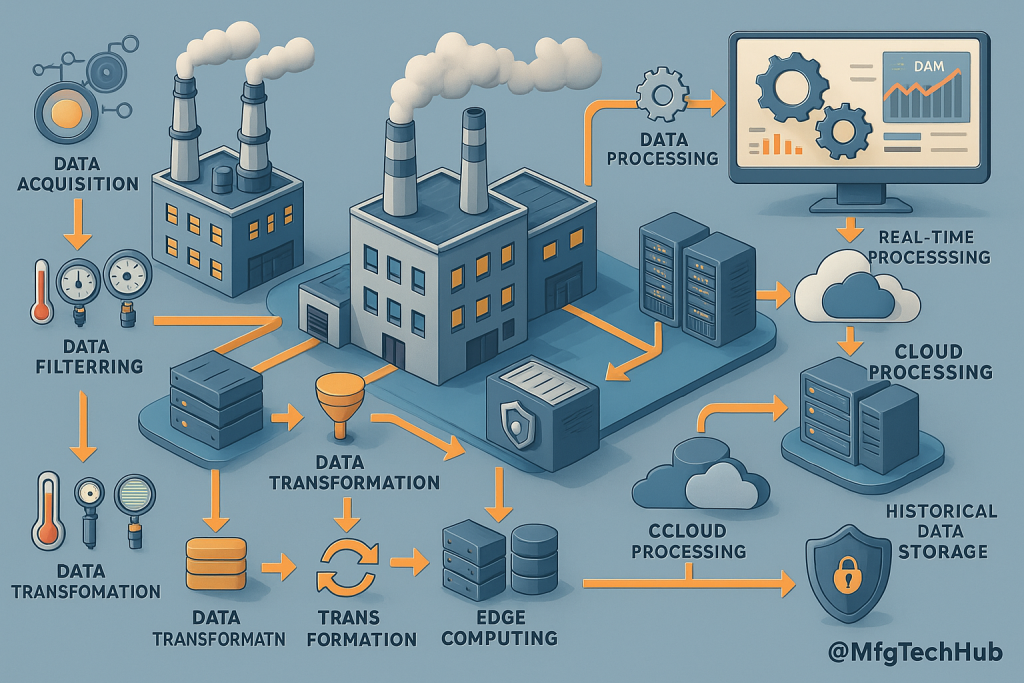SCADA Systems Components: Data Processing 🚀

1. Introduction to SCADA Data Processing
SCADA systems generate vast amounts of real-time data from sensors, RTUs, and PLCs. However, raw data alone is not useful—it must be processed, analyzed, and interpreted to provide meaningful insights for decision-making.
📌 Example: In an oil refinery, SCADA continuously collects pressure and temperature data from pipelines. Data processing algorithms analyze these readings to detect leaks or operational inefficiencies before failures occur.
🔹 Why is Data Processing Important?
✅ Converts raw sensor data into actionable insights.
✅ Enables real-time control & decision-making in industrial operations.
✅ Enhances efficiency, reliability, and predictive maintenance.
✅ Supports historical trend analysis and performance benchmarking.
2. Key Components of SCADA Data Processing
SCADA data processing involves multiple hardware and software elements working together to filter, analyze, and store industrial data.
A. SCADA Servers
🖥 Function: Central hub where all acquired data is stored, analyzed, and distributed.
💡 Example: A SCADA server in a power grid collects voltage levels from different substations and balances loads in real-time.
B. Data Processing Algorithms
📊 Function: Interpret sensor data, detect anomalies, and trigger actions.
💡 Example: An AI-based SCADA system predicts when a pump motor might fail, enabling preventive maintenance.
C. Data Filters & Noise Reduction
🔍 Function: Eliminate inconsistent, redundant, or irrelevant data.
💡 Example: A temperature sensor may generate minor fluctuations—filters remove insignificant noise to focus on critical changes.
D. Data Aggregation & Transformation
🔄 Function: Consolidate multiple data streams into structured reports.
💡 Example: A water utility SCADA aggregates flow rate data from multiple sensors to optimize water distribution.
E. SCADA Historical Data Storage
📂 Function: Archive processed data for trend analysis, audits, and compliance.
💡 Example: A pharmaceutical SCADA system logs temperature and humidity records to ensure compliance with FDA regulations.
3. How SCADA Data Processing Works
SCADA data processing follows a structured workflow, transforming raw data into useful information.
Step 1: Data Acquisition
📌 Sensors measure physical parameters such as temperature, pressure, and flow.
📌 Data is transmitted to RTUs, PLCs, or SCADA servers.
Step 2: Data Filtering & Cleaning
📌 Redundant, erroneous, or fluctuating data is filtered out.
📌 Missing data points are interpolated for continuity.
Step 3: Data Transformation
📌 Raw data is converted into standardized formats for analysis.
📌 Unit conversions (e.g., Celsius to Fahrenheit) are performed.
Step 4: Real-Time Processing & Analysis
📌 SCADA detects anomalies like pressure drops or equipment overheating.
📌 If an issue is detected, SCADA triggers alerts or corrective actions.
Step 5: Data Storage & Trend Analysis
📌 Processed data is stored in databases or cloud platforms.
📌 Operators analyze trends to predict future failures or optimize operations.
4. Techniques Used in SCADA Data Processing
SCADA data processing techniques enhance efficiency, decision-making, and automation.
A. Real-Time Data Analytics
🔹 Function: SCADA analyzes data as it is received.
💡 Example: A manufacturing SCADA system detects production delays and adjusts assembly line speed.
B. Predictive Analytics (AI & Machine Learning)
🔹 Function: AI-powered SCADA predicts failures and optimizes performance.
💡 Example: AI-based SCADA in wind farms predicts turbine wear & tear, reducing unplanned maintenance.
C. Edge Computing for Faster Processing
🔹 Function: SCADA processes data locally instead of sending it to central servers.
💡 Example: Oil pipeline SCADA systems use edge computing to detect pressure anomalies in real time.
D. Cloud-Based Data Processing
🔹 Function: Stores and analyzes SCADA data remotely on cloud platforms.
💡 Example: A smart city SCADA system stores traffic data in the cloud, optimizing signal timings.
5. Cybersecurity Challenges in SCADA Data Processing
🚨 SCADA data processing systems are prime targets for cyber threats, requiring strict security measures.
A. Common Security Threats
🦠 Malware Attacks: Hackers inject malware into SCADA servers, corrupting critical data.
🚫 Unauthorized Data Manipulation: Attackers alter data processing parameters, leading to false alarms or process failures.
📡 Data Breaches: Sensitive industrial data is leaked due to weak security controls.
B. Best Practices for Securing SCADA Data Processing
✅ Data Encryption: Use AES-256 encryption to protect SCADA data.
✅ Access Control: Implement multi-factor authentication (MFA) for SCADA servers.
✅ Intrusion Detection Systems: Deploy AI-based threat monitoring for early detection of cyberattacks.
✅ Regular Audits: Perform periodic security audits to find vulnerabilities.
6. Case Study: SCADA Data Processing in Smart Grid Optimization
Problem:
A national power utility faced frequent voltage fluctuations due to an outdated SCADA data processing system.
Solution:
🔹 Upgraded to AI-driven SCADA data processing for predictive voltage regulation.
🔹 Implemented real-time analytics to detect load imbalances and redistribute power efficiently.
🔹 Integrated cloud storage for historical trend analysis and forecasting.
Outcome:
✅ Improved power grid stability by 40%.
✅ Reduced blackouts by 50% through predictive analytics.
✅ Optimized energy distribution, lowering operational costs by 20%.
SCADA data processing is the brain of industrial automation, converting raw data into meaningful insights for decision-making. With advancements in real-time analytics, AI, edge computing, and cloud integration, SCADA data processing is becoming smarter, faster, and more secure.

Thanks for sharing such a good thought, piece of writing is good, thats why i have read it entirely